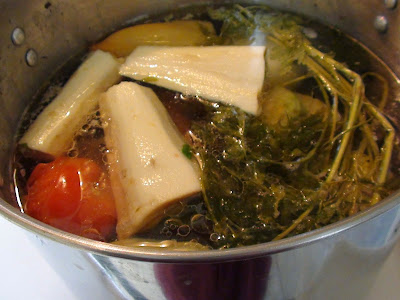Named after a Hungarian actor, this was the first course on the menu when Jim and I got married in 1967. Another name for it is wedding soup. It’s a clear, meat rich soup with lots of vegetables and extra fine soup noodles or very thin broad noodles. The secret is in the slow cooking. You don’t boil it and you mustn’t stir it. Put it on the stove on low heat; it mustn’t come to boil not even at the beginning. You don’t put a lid on the pot and it shouldn’t really simmer even… There is a word for it in Hungarian; gyöngyödzik – this soup has to sweat more than simmer. These little grease spots will appear on the top and kind of vibrate a bit. That is how you cook the Újházi. The original soup calls for hen actually, but that would have taken too long to cook. So I settled for chicken. But the taste was pretty much the same. And it only cooked for six hours before it was ready. The noodles should be freshly made but the afternoon was busier than I anticipated so I rolled out a leaf of broad noodles instead of chopping the extra fine. Újházi calls for a few fresh peas floating in it, but I only had frozen peas and those would have made the soup sweet. People sometimes drop in a small mushroom or two, but not the bottom mushrooms; those would make the soup brown. In Hungary they use tiny flat topped “csiperke” mushroom, so I had to omit that. I have read somewhere to put in the onion in its skin, which is wrong, onion skin is used for purple dye and you don’t want your Újházi purple! Újházi should have a deep yellow broth, in fact you can put a little saffron in it for that very reason, but that is optional.
Here we are in 1967 with a tureen of Újházi Chicken Soup
UJHAZI CHICKEN SOUP
an entire chicken breast with skin and bones intact, cut into 2 pieces6 large thighs with skin and bones intact
20 cups water
1 large onion in whole, peeled
4 cloves of garlic, peeled
12 peppercorns
salt
1 pkg. fresh broad leaf parsley
1 fresh tomato in whole
1 fresh yellow pepper [preferably sweet Hungarian, but bell pepper will do] with top cut off and seeds removed
1 smallish piece of ginger, peeled
1/4 of a cauliflower in one piece
1 whole kohlrabi, peeled
1 celery root [not celery], peeled
4-6 large carrots in whole, peeled
3-4 parsnips in whole, peeled
1 Tbsp fresh green peas, [not frozen], shelled
3-4 small csiperke mushrooms, [no substitution] washed and top peeled
• Chop, wash and dry the meat with paper towels.
• Add the meat and cold water to the stockpot.
• Begin cooking on low heat.
• Do not let the water come to the boil. Soup should just sweat instead of simmer. Small circles of fat will come to the surface and vibrate. Do NOT at any time stir the pot. That is how Újházi cooks.
• Peel and wash all the vegetables, but do not chop them, [keep them whole]. Set them aside for use later.
• As the soup sweats, some scum will float to the top. Scoop those off with a slotted spoon.
• When you think no more sum will come to the top add the salt, onion, fresh parsley, peppercorns, paprika, tomato and the ginger.
• Let the soup sweat for 2-3 hours.
• Meanwhile make the fresh noodle pasta and set it aside for use later.
• When the meat in the soup is getting close to being tender add the cauliflower florets, the carrots, parsnips, kohlrabi and the celery root. Do not raise the heat. Let the soup sweat.
• When the vegetables look almost tender that is the time to add the fresh green peas and the csiperke mushrooms. If you don’t have these, omit this step.
• When the soup has been sweating for six hours or more and the meat and all the vegetables are tender, gently pour the broth through a large fine sieve into a clean soup pot.
• Let the meat and the vegetables cool a bit.
• Place on a clean cutting board and cut the breast meat into serving size pieces.
• Keep the thighs as they are but remove and discard all the skins. Put the tidied up meat back in the soup.
• Slice the carrots, parsnips, kohlrabi and the celery root. Put these back in the soup.
• If you can find peas and mushrooms intact put these back in the soup. Discard all the other vegetables.
• Ladle some of the soup into a small pot and cook the noodles. Discard the broth the noodles were cooked in and with a slotted spoon transfer the noodles into the soup.
• Gently heat through and the Újházi Chicken Soup is ready to serve.









